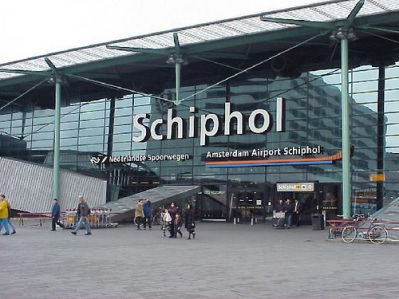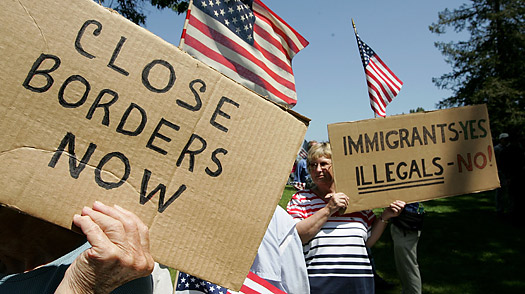 Issues with airport security have gotten a ton of press in recent years. On television, each attempted terrorist attack obviously gets intense coverage which, in turn, keeps airports on their toes. For example, Schiphol Airport from which the Christmas day terrorist passed through got a wake up call to tighten their safety measures when they saw a report on television specifically directed at their inspection of liquids at security check points. An undercover operation was exercised where liquids planted by the reporters again passed through security even days after the Christmas day attack. When this story aired on television the Dutch airport made sure to strictly enforce security inspections to avoid gaining a worse reputation. This television report was very informative and helped improve airline safety—technically on an international level.
Issues with airport security have gotten a ton of press in recent years. On television, each attempted terrorist attack obviously gets intense coverage which, in turn, keeps airports on their toes. For example, Schiphol Airport from which the Christmas day terrorist passed through got a wake up call to tighten their safety measures when they saw a report on television specifically directed at their inspection of liquids at security check points. An undercover operation was exercised where liquids planted by the reporters again passed through security even days after the Christmas day attack. When this story aired on television the Dutch airport made sure to strictly enforce security inspections to avoid gaining a worse reputation. This television report was very informative and helped improve airline safety—technically on an international level.
News on television usually has the reputation, especially on the local level, of covering “bad” news such as murders, robberies, etc. On a national level, the main stories tend to be about politics, celebrities, and national “bad” news, which definitely includes various national security breaches. As we have discussed in class media holds people and businesses accountable for their every move. In this case, a news story on television held Schiphol Airport responsible for a major attempted terrorist attack and called them out when they did not make much needed changes in their security.
Criticism of Airport Security
Ever since the terrorist attacks of September 11, 2001 airport security has been a hot topic in the media. The process of checking your bag, examining carry-ons, and passing through the metal detector has become much more than a simple procedure. Many articles in newspapers such as the New York Times criticize the security check processes in airports pointing out some of the ridiculous episodes travelers have encountered with airport security. For example, one reporter explained how he had to make his parrot spread its wings in order to be checked for anything suspicious. He entitled the article “Take Off Your Shoes, and Is the Parrot Loaded?” I came across many articles like this that seemed to ridicule such intense precautions. However, would you rather have a less daunting security inspection with the chance of leaking a terrorist on your flight? Doubtful.
Although airports around the world are cracking down on security by investing in more advanced scanning machines, detectors, etc many of those machines have proven to be less than effective. This does not give airports any more good press, to say the least. The Transportation Security Administration is doing everything in its power to establish an efficient and successful security system for travelers but it seems to be a slow process until they have another wake-up call such as the recent incident of the attempted attack in Detroit.
Preventative measures taken by airports also include racial profiling, which raises much debate that will be discussed in a later blog.

The Need for Immigration
Immigration is indeed a key element in a nation’s security plan. It naturally occurs all over the world because people will inevitably look for new places if their current situation is unsatisfactory. If it is necessary, they will go travel across borders if that is where they can find available jobs. In America, the issue of border control has become a hot topic in the past decade. In order to keep the country safe, immigration does have to be properly controlled and regulated. However, there is another issue on the flipside, which is how many immigrants are needed to keep America up and running.
The reality, whether people like it or not, is that some industries absolutely depend on immigration (illegal or not) to keep business going. One of the most notable areas is agriculture. With tougher immigration laws and increased border patrol security, farmers have felt the heat when looking for people to employ. There’s a reason so many illegal immigrants are found working on American farms. The current immigration laws do not come close to allowing enough workers to come over and help produce the food we live off of. Recently, famers have made pleas to congress without much success to speak of. In order for changes to occur, our current green card laws will have to be made more flexible to potential agricultural workers. The next question that arises is: how does this fit in with the increased need for national security since the 9/11 terrorists attacks? There is no easy answer, but lawmakers will have to find a way if we plan on keeping these important industries stable.
Virtual Borders and the 5 miles of US-Canadian Border fencing.
Like with anything, securing our nation starts with a perimeter. There are over 7,400 miles of land boundaries, and 12,300 miles of coastline. While most people imagine that there is a wall and facility similar to the large US/Mexico border crossings, in reality the protection rages from these massive, intricate walls and roadblocks to what are shockingly the vast majority of our border, completely unguarded and blind border crossings.
To build a wall, with defenses, border guards and border crossings over all 7,400 miles is an unreasonable task. Cost set aside, much of the border is in the remote wilderness, whether a Texan Desert or 150 miles from the nearest inhabitant in northern Maine. While all roads crossings the border have at least a part-time Customs and Border Patrol station, we hear frequently stories about human traffickers or drug smugglers crossing the unguarded desert, and the only way we knew is that the body was found some time later by a routine patrol.
With the push for homeland security, along with the technological advances of late, we are able to better protect our borders without manning and building a wall across the entire border. With tensions rising along the southern border, the US is implementing drones, or UAV’s to silently, remotely and automatically monitor the entire border, from a vantage point that will allow them to see more, and with less effort. With this, via a remote control center, the border agents can be better used where they are needed, rather than monitoring a very small point.
All in all, CBP is still investing in permanent defenses. Their website offers you a map with the update on construction of an actual fence spanning completely from the western tip of Texas to California. The image is to the right. I think that the hybrid system works well, focusing the “hard” border on more populated areas, while using technology to protect the broader, sparser border in Texas. One thing to consider, the Canadian border has a negligible amount of hard defenses, and even less technological defenses. While the US/Mexico border is a risk for immediate crime and drug trafficking, as witnessed by 9/11, the weak security between the two has already been exploited to do even greater damage. fence_map
While NEXUS cards allow commuters to pass from the US to Canada without inspection, there are still thousands of miles of border with nothing but a granite marker every several yards to mark it. When I researched as to why (other than the perceived safety of Canada, being similar and not known for hostility or smuggling at the border) I found that Canada did not feel that it was necessary when the US proposed one. As a result, the border will be monitored electronically.
What strikes me, is that to enter the United States from a European Union flight, you have to complete landing cards, are inspected; to enter by car you are sometimes stopped, and randomly inspected; but to drive across a logging road in Canada be undetected sets off some warning bells for me. I just hope that this loophole is not exploited… again.
Introduction to the Immigration System’s Policies & an Overview of its Potential Drawbacks
In correlation with the recent increase in number of illegal immigrants to the United States, mass media coverage of this issue has risen as well. This increasingly large group of immigrants has formed a “new community”, which is one of the
trends that is appealing to the mass media publishers. As a result of strong and opposing opinions on the subject being articulated by the democrat and republican political parties, “demassification” (or fragmentation between these two audiences) has also occurred. In order to fully understand both the positive and negative implications of the current immigration policies it is necessary to first define immigrants and to explore the impact that current US policies have on these immigrants.
Permanent legal immigration is not only limited in the number of spots that the US offers, but immigrants are also torequired to categorized into one of four categories:
1. Family Based Immigration
2. Employment Based Immigration
3. Humanitarian- based immigration
4. Other

Although these categories appear to be somewhat inclusive, there are specific regulations within these broad categories that limit the number of immigrants who qualify (by the government’s standards) to migrate to the US. The first issue arises
in the fact that there are “an insufficient number of visas”; this cap was set in the 1990s and has not been change to fit the evolving economy and labor market. In regards to the “family based immigration”, the category is limiting because it only allows a US citizen the right to petition for a their spouse, child, parent, or sibling (no exceptions to these limits are considered). Concerning the “employment-based immigration”, the employer must not only offer a job to the immigrant, but
also be willing to sponsor him or her financially; also, this process is often costly in time and money which is a large deterrent for employers. Finally, “humanitarian based-immigration” is confining as well because not only is there a pre-set
number for this category, but the potential immigrant must also prove to the US government that they have a “well-founded fear of persecution”, which is subject to the government’s discretion.
Anti-Immigration Media Coverage
National security is one of the most frequently discussed topics in the news today, as many different media sources cover this subject from varying points of view. Immigration, specifically illegal immigration, is one of these widely visible issues. Much of this coverage relates to the problems caused by immigration to the United States, with many anti-immigration organizations publishing articles about this problem. While the audience is clearly aware that these groups are biased, the media that they produce is often very convincing as they concentrate on the ways in which immigration negatively affects their readers on a personal level. By claiming that immigration hurts the economy and detracts from American heritage, these institutions directly relate the issue to the public, thereby winning over the audience’s support.

One of these institutions is RenewAmerica, a group claiming that “America must return to its founding principles if it is to survive.” RenewAmerica writer Neil Brian Goldberg’s recent article “It is not Immigration!” focuses on this viewpoint, explaining how illegal immigration has harmed the United States as a whole. He urges readers to support laws that will:
- Seal borders more effectively
- Take serious offenders from prison and deport them to their countries of origin
Sources like this one are primarily persuasive and informational, as they attempt to convince readers to agree with their anti-immigration perspective. In the past, immigration has not been a focal point for the media, however with growing global awareness, national security now relates to immigration much more. An increase in globalization has in turn created political controversy over this issue, as producers of mass media take opposing sides while reporting about the immigration debate. Institutional sources, although biased, provide in-depth information for audiences as they persuade readers to agree with their viewpoint.